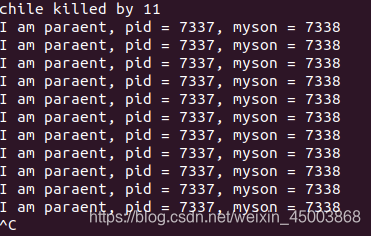linux之wait函数
linux之wait函数wait函数:成功:清理掉的子进程 ID;失败:-1 (没有子进程)#include <sys/types.h>#include <sys/wait.h>pid_t wait(int *wstatus);wstatus是传出参数,a.wait函数有3个功能:(1)阻塞等待子进程退出(2)回收子进程残留资源(3)获取子进程结束状态(退出原因)。b.可使
linux之wait函数
wait函数:成功:清理掉的子进程 ID;失败:-1 (没有子进程)
#include <sys/types.h>
#include <sys/wait.h>
pid_t wait(int *wstatus);
wstatus是传出参数,
a.wait函数有3个功能:
(1)阻塞等待子进程退出
(2)回收子进程残留资源
(3)获取子进程结束状态(退出原因)。
b.可使用 wait 函数传出参数 status 来保存进程的退出状态。借助宏函数来进一步判断进程终止的具体原因。常用的宏函数可分为如下两组:
(1)WIFEXITED(status)为非0 -----------进程正常结束
如果宏函数WIFEXITED(status)的返回值为真(非0),则进一步调用宏函数WEXITSTATUS(status),此函数返回的是子进程退出的值,比如exit(10),返回值就是10
(2) WEXITSTATUS(status) 如上宏为真,使用此宏---------获取进程退出状态 (exit 的参数)
(3)WIFSIGNALED(status)为非0----------进程异常终止
如果宏函数WIFSIGNALED(status)的返回值为真(非0),则进一步调用宏函数WTERMSIG(status),此函数返回的是使子进程终止的那个信号的编号
(3) WTERMSIG(status) 如上宏为真,使用此宏----------取得使进程终止的那个信号的编号
wait函数的使用:wait.c
#include <stdio.h>
#include <stdlib.h>
#include <unistd.h>
#include <sys/types.h>
#include <sys/wait.h>
int main()
{
pid_t pid,wpid;
int status;
pid = fork();
if(pid==0){
//让子进程异常退出
execl("abnor","abnor",NULL);
printf("---child, my parent=%d, going to sleep 3s\n",getppid());
sleep(60);
printf("--------------child die--------------\n");
//exit(76);
return 100;
}
else if(pid>0){
wpid = wait(&status);//子进程的退出状态保存在status中
if(wpid==-1){
perror("wait error:");
exit(1);
}
//子进程正常退出
if(WIFEXITED(status)){//如果宏函数WIFEXITED(status)的返回值为真,则继续调用宏函数WEXITSTATUS(status),此函数返回的是子进程退出的值
printf("child exit with %d\n",WEXITSTATUS(status));
}
//子进程异常退出
//测试子进程异常退出(不是子进程自己异常):运行程序之后,新开终端 ps aux ,杀掉子进程,此时会打印 child killed by ...
if(WIFSIGNALED(status)){
printf("chile killed by %d\n",WTERMSIG(status));
}
while(1){
printf("I am paraent, pid = %d, myson = %d\n",getpid(),pid);
sleep(1);
}
}
else{
perror("fork");
return 1;
}
return 0;
}
结果:

更多推荐
 已为社区贡献4条内容
已为社区贡献4条内容









所有评论(0)